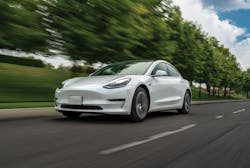The United States is the third-largest electric vehicle (EV) market in the world behind China and Europe. More than 1.74 million light-duty, plug-in electric vehicles have been sold in the U.S. since 2010. EV registrations in the U.S. reached a record market share of 1.8% during 2020, according to IHS Markit.
While still making up a relatively small percentage of all personal vehicles sold in the U.S., the number of EVs on American roads is expected to multiply over the next several years as governments and vehicle manufacturers pursue electrification, while historic hurdles to widespread EV acceptance — including “range anxiety” and high retail prices — reduce in significance. (IHS Markit believes that EVs will account for 3.5% of light-duty vehicles sold in the U.S. during 2021 and more than 10% by 2025.)
This shift presents challenges for tire dealers, who will need to know how to service electric vehicles, and for tire manufacturers, who are engineering and building tires that are specifically tuned to EV design and performance.
The differences between present-day electric vehicles and traditional, gas-powered vehicles are significant. EVs are generally heavier than their internal combustion engine-equipped counterparts. They generate more torque and less noise. And EV range is not always comparable to what a tank of gas can deliver, although OEMs are working hard to extend range limits. (Last month, General Motors announced that it is developing an all-electric version of the Chevy Silverado pickup that will have a 400-mile range.)
MTD recently spoke with tire manufacturers who have an original equipment presence in the U.S. to learn how EVs are impacting tire design and construction.
A weighty matter
EVs are typically heavier than comparable gas-powered cars. (The Tesla Model 3 sedan tips the scales at around 3,500 pounds. The Honda Civic sedan, a similarly sized car, weighs around 2,900 pounds.)
“Due to the weight of their batteries, the overall weight of the electric vehicle tends to be heavier,” says Richard Smallwood, CEO and president of Sumitomo Rubber North America Inc. “As battery technology advances, that weight disparity will diminish — possibly disappearing entirely — but today the weight difference is in the 15% to 20% range, depending on the model of the vehicle.
“As we know, greater vehicle weight has a negative impact on the life of the tire and the handling characteristics of the tire and vehicle combination,” he says.
Robin Wilkes, vice president of original equipment, Pirelli Tire North America, says tire manufacturers “have to make sure that tires of the same size have the ability to carry the extra weight” of EVs. “Sometimes this can be done by changing the tire’s size. But beyond that, you have the high load capacity (tire) designation, which is creeping up in Europe and in the past, we really didn’t have a need for.”
“EVs are pushing the envelope of tire design in terms of load carrying capabilities,” says Mauricio Mendez Sotelo, technical product management, research and development, passenger and light truck tires, Continental Tire the Americas LLC.
“Tires need to be able to carry higher loads and require higher inflation pressure in order to carry that load. Original equipment manufacturers are looking at, ‘How can we make tires with the dimensions we currently have that can carry the higher load, without building bigger tires?’”
“The vast majority of EV tires on the market are currently in XL sizes to accommodate the increased load,” says Ben Patel, senior vice president and chief technology officer, Cooper Tire & Rubber Co. “And some manufacturers have announced intent to begin making ‘HL’- designated tires for even more capacity. This requires a more robust and heavier construction.”
Instant torque
“Another interesting thing about EVs is the instantaneous torque” they create “and the fact that EVs can generate 100% of their torque at zero rpm,” says Dale Harrigle, chief engineer for product development, consumer replacement, Bridgestone Americas Inc.
“There is a lot of work going on with tire wear — first off, understanding the implications of EVs on wear and also how we adjust tire construction and patterns to give customers the long wear life they are used to.
“In addition, (EV) braking characteristics are slightly different than classic vehicles with conventional brakes,” he says. “We have to understand how all of those factors affect wear over the lifespan of the tire. I think a lot will come down to material technology and some tread pattern technology.”
Thomas Kenny, senior director of research and development for Yokohama Tire Corp., says a 20% loss in treadwear “is not uncommon” with high-torque electric vehicles.
“Tires used for EV applications will require a paradigm shift in the way they are designed if they are to perform at a level commensurate with their non-EV counterparts. This includes a stiffer tread block design, the use of more robust construction and in some cases, new compound technology.”
Cut the noise
The absence of gas-powered engines and all the sounds they generate means EV tires must be engineered to produce even less noise than usual.
“Weight and torque are certainly the issues you hear the most about” when EVs are discussed, says Aaron Neumann, product development manager at Nexen Tire America Inc.’s technical center.
“But those aren’t probably our top two concerns. As we develop tires for EVs, there is greater emphasis on noise and vibration. If you’ve had a chance to ride in an EV, you’ll know how smooth and quiet they are.
“The electric motor does not produce near the vibration of the internal combustion engine, which has been masking noise and vibration from other parts of the vehicle for a while,” notes Neumann. “Any noise or vibration that comes from the tire is more pronounced” in an electric vehicle.
“Noise is probably more annoying” to EV owners than it is to traditional car owners, according to Rodrigo Uso, senior technical account manager and technical sales team leader, North America, Hankook Tire America Corp.
To EV drivers, “tire noise becomes super-important and manufacturers are looking at noise from a different perspective,” he says.
There are some unique technologies that have been introduced on tires for EVs, including a foam absorber — pretty much a piece of foam that is attached to the inside of the tire that’s going to help absorb cavity noise.”
Within range
Low rolling resistance tires are normally associated with gas-powered vehicles. But in order to optimize battery range, EVs also require low rolling resistance tires, according to Rick Cunat, managing director of Kumho Tire USA Inc.’s Americas technical center.
“For tires, the primary source of drag is rolling resistance. In addition, the aerodynamics of the tire contribute to the vehicle’s overall drag.
“There are many ways tire manufacturers can address rolling resistance through innovative materials and tire cavity shape to maximize all performance attributes that EVs demand.” Consumers “are looking for range and tire life. That’s the whole game.”
“The focus on tire performance has been elevated” by EVs, says Steve Calder, technical marketing manager, Michelin North America Inc. “In general, with an internal combustion engine, roughly 20% of the fuel burn is used to overcome the rolling resistance of the tire, so any improvement we can make in rolling resistance has a direct impact on the vehicle.”
The same principle applies to electric vehicles, he adds. “You can (gain) range if you put on a tire that has very low rolling resistance versus putting on a traditional tire.”
Down the road
While tire manufacturers continue to hone today’s EV tire technology and design, they also are eyeing what’s next.
“If you look at tire performance today versus 20 years ago, we’ve made huge gains,” says SRNA’s Smallwood. “The thresholds continue to get higher. Twenty years from now, the tires for EVs will probably be better than our best-handling tires today.”
Tire dealers also should be aware that the number of EV tires available in the replacement channel will increase over time, says Conrad Galamgam, vice president, product planning and technical services, Toyo Tire U.S.A. Corp.
“With the proliferation of EVs over the next decade, it will be more important than ever to monitor new tire sizes, higher load carrying capacities and ideal performance ratings to match the requirements of these new vehicles and enhance the electric vehicle experience.”
About the Author
Mike Manges
Editor
Mike Manges is Modern Tire Dealer’s editor. A 28-year tire industry veteran, he is a three-time International Automotive Media Association Award winner, holds a Gold Award from the Association of Automotive Publication Editors and was named a finalist for the prestigious Jesse H. Neal Award - often referred to as "the Pulitzer Prize of business-to-business media" - in 2024. He also was named Endeavor Business Media's Editor of the Year in 2024. Mike has traveled the world in pursuit of stories that will help independent tire dealers move their businesses forward. Before rejoining MTD in 2019, he held corporate communications positions at two Fortune 500 companies and served as MTD’s senior editor from 2000 to 2010.

